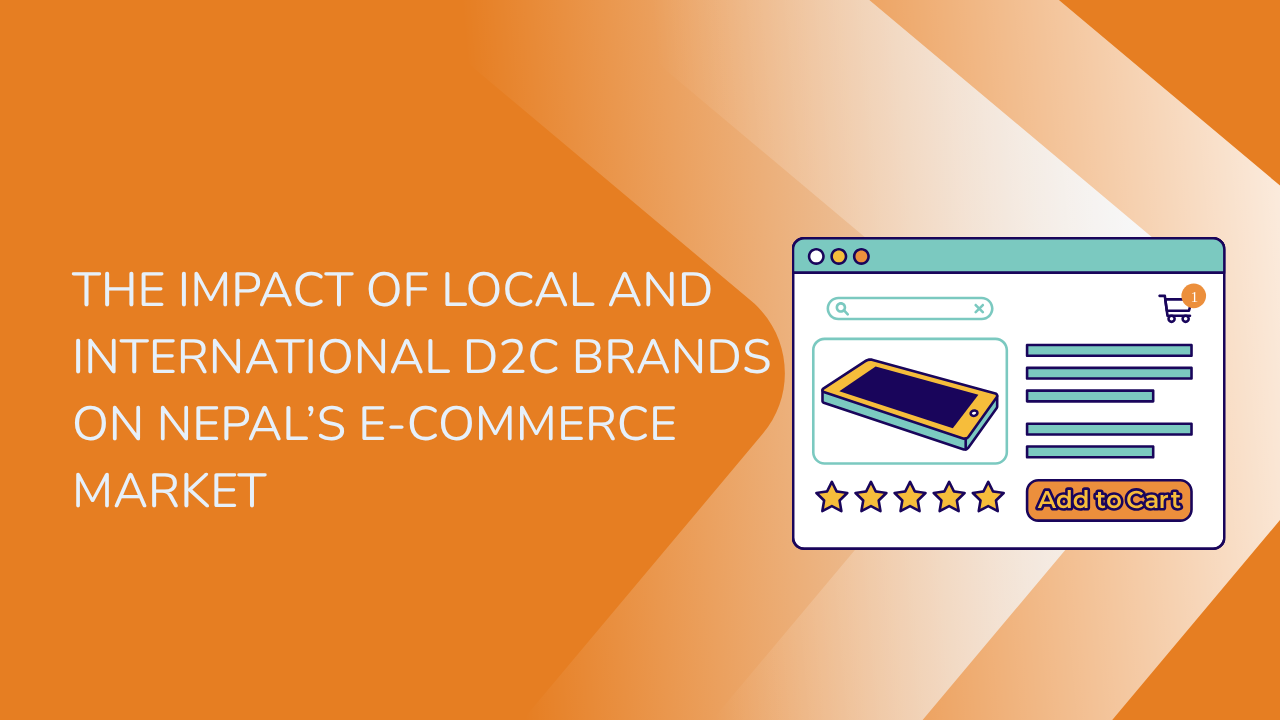Share this Article
In the rapidly evolving world of e-commerce, Nepal’s retail landscape is undergoing significant transformation, driven in large part by the rise of Direct-to-Consumer (D2C) brands. Both local and international D2C brands are playing a pivotal role in reshaping how Nepali consumers shop, interact with brands, and make purchasing decisions. As the country’s digital infrastructure improves and consumer behavior shifts, the presence of D2C brands, both domestic and foreign, is becoming more prominent. This article will explore how local and international D2C brands are influencing Nepal's e-commerce market, the challenges they face, and how they are contributing to the overall retail ecosystem in Nepal.
Understanding D2C Brands and Their Growth
D2C brands refer to businesses that bypass traditional distribution channels, selling their products directly to consumers via digital platforms. This model allows brands to have complete control over the customer experience, from product development to marketing and sales. In Nepal, the concept of D2C brands is gaining traction, fueled by the growth of internet access, digital payment systems, and e-commerce platforms. Both local and international brands are embracing this model as a way to connect directly with their target audience.
For local D2C brands, this model offers an opportunity to tap into the growing online shopping trend in Nepal without relying on intermediaries like physical retail stores or third-party sellers. Similarly, international D2C brands see Nepal as a burgeoning market for their products and are looking to establish a direct presence with Nepalese consumers, bypassing the traditional distribution routes that could otherwise limit their reach.
The Rise of Local D2C Brands in Nepal
Local D2C brands in Nepal have seen tremendous growth in recent years, driven by the increasing use of social media, the rise of e-commerce platforms, and a shift in consumer purchasing behavior. Brands like Gorib, MeroShopping, Tandoor Foods, and many others are capturing the attention of consumers with their innovative products and localized marketing strategies.
Challenges Faced by Local D2C Brands
While local D2C brands have found success, they face several challenges unique to the Nepali market:
- Logistics and Delivery Issues: One of the most significant barriers for local D2C brands is efficient logistics. Nepal's geographical terrain, consisting of mountains, valleys, and remote areas, makes it challenging to provide consistent delivery services. Though Kathmandu, Pokhara, and a few other urban centers have more robust infrastructure, rural areas are often left underserved.
- Payment Systems: Many Nepali consumers still prefer to pay with cash-on-delivery (COD) rather than online payment methods. While there has been a rise in digital payment solutions like e-banking, mobile wallets, and online payment systems, cash payments continue to dominate. This creates challenges for D2C brands in managing inventory, cash flow, and delivery scheduling.
- Building Trust: Trust is a crucial factor in the D2C model, especially in markets like Nepal where online shopping is still in its nascent stages. Local D2C brands need to build credibility, showcase quality assurance, and provide excellent customer service to gain consumer trust and encourage repeat purchases.
- Competition from Established Brands: Local D2C brands also face stiff competition from well-established players in Nepal's traditional retail market. Many consumers still prefer shopping in physical stores where they can touch and feel the product. Local D2C brands need to find ways to convince these consumers to switch to online shopping.
Success Factors for Local D2C Brands
Despite these challenges, several local D2C brands in Nepal are thriving. Some of the success factors include:
- Social Media Engagement: Local D2C brands are making the most of social media platforms like Facebook, Instagram, and TikTok to engage with customers directly. Through targeted ads, influencer collaborations, and user-generated content, these brands can create awareness and build relationships with their audience.
- Personalized Marketing: Local D2C brands in Nepal have a unique advantage in being able to personalize their offerings and marketing strategies. Many of these brands cater to specific cultural preferences, regional tastes, and consumer behavior patterns, giving them an edge over international brands that may not be as attuned to the local market.
- Affordable Pricing: Local brands often have the ability to offer competitive prices due to lower operational costs. By cutting out the middleman, these brands are able to sell their products at more affordable rates, making them more attractive to price-conscious consumers.
- Focus on Quality and Customer Experience: Offering high-quality products and ensuring excellent customer service have been key to the success of local D2C brands. Brands that prioritize the end-to-end customer journey, from browsing to post-purchase support, tend to build strong customer loyalty and receive repeat business.
The Role of International D2C Brands in Nepal’s E-Commerce Market
International D2C brands, including global giants like Nike, Apple, Amazon, and H&M, are also making their mark in Nepal’s e-commerce space. With a growing middle class and increasing smartphone penetration, Nepal has become an attractive market for global brands to expand their direct-to-consumer channels.
Advantages for International D2C Brands
- Brand Recognition: International D2C brands already enjoy significant brand recognition in Nepal. Consumers are often familiar with these brands through advertising, word-of-mouth, or previous exposure. This gives international D2C brands a significant advantage over local competitors, particularly in categories like electronics, fashion, and lifestyle products.
- International Payment Systems: International brands often bring with them advanced payment systems and digital infrastructure. Payment gateways, secure online payment methods, and the ability to accept international credit cards have made it easier for Nepali consumers to purchase from global D2C brands.
- Wide Product Range: International brands can offer a wide array of products that local brands may not be able to match, especially in high-end electronics, luxury items, and global fashion trends. As a result, consumers in Nepal are attracted to the variety and quality that international D2C brands offer.
Challenges for International D2C Brands
Despite their advantages, international D2C brands face challenges when entering the Nepali market:
- Cultural Differences: While global brands are already well-known, they must adapt to the cultural preferences and expectations of Nepali consumers. This includes localizing product offerings, marketing strategies, and customer service experiences to align with local values and tastes.
- Logistical Barriers: While international brands may have the financial resources to invest in better logistics, they still face the same challenges as local D2C brands when it comes to shipping products across Nepal’s challenging terrain. Additionally, international shipping can incur significant costs, making their products less affordable for price-sensitive consumers.
- Regulatory Challenges: Navigating Nepal’s import regulations, taxes, and customs procedures can be a complicated process for international D2C brands. The government’s policies related to e-commerce and cross-border transactions may create additional hurdles for global brands.
- Customer Acquisition and Retention: For international brands, acquiring customers in Nepal involves overcoming trust barriers. Many Nepali consumers still prefer shopping from local stores, where they can physically inspect products before making a purchase.
The Fusion of Local and International D2C Brands
Interestingly, the rise of both local and international D2C brands in Nepal is fostering a unique competitive environment. While local brands cater to the specific needs and preferences of Nepali consumers, international brands are setting higher standards in terms of product quality, customer experience, and brand image.
Both local and international brands are benefiting from the shared growth of e-commerce infrastructure in Nepal. They are leveraging digital platforms, social media, influencer marketing, and other innovative strategies to enhance their reach, build customer loyalty, and drive sales.
Conclusion
The presence of local and international D2C brands is reshaping Nepal’s e-commerce market in profound ways. Local brands are capitalizing on their understanding of the Nepali consumer, using social media, personalized marketing, and affordability to build successful businesses. Meanwhile, international brands bring brand recognition, a diverse range of products, and advanced digital infrastructure to meet the evolving needs of the Nepali consumer.
Both sets of brands face unique challenges but are continuously finding ways to adapt and innovate. As Nepal’s e-commerce market continues to grow, both local and international D2C brands will likely play an increasingly significant role in shaping the country’s retail landscape. The competition between these brands is driving improvements in customer experience, expanding product options, and elevating the standards of digital commerce in Nepal. As more consumers embrace online shopping, the influence of D2C brands in Nepal’s retail market is only set to increase, offering a glimpse into the future of retail in the country.
Categories:
Beginner’s Guides
Tags:
local businesses
,
e-commerce app
,
Small Business
,
strong brand
,
E-commerce







